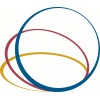
Contact Lenses and Myopia
MyopiaThe objective of this study is to determine if multifocal contact lenses affect accommodation and/or binocular vision when worn by pediatric patients. This will be accomplished through subjective and objective accommodative and binocular experiments in children wearing single vision and multifocal soft contact lenses.

Ultrastructure Analysis of Excised Internal Limiting Membrane in Eyes of Highly Myopia With Myopic...
Myopic Traction MaculopathyThe excised ILM from 7 eyes of 7 patients with MTM including 7 eyes with macular retinoschisis and 4 eyes with foveal detachment but without any retinal break underwent vitrectomy with induction of posterior vitreous detachment and ILM peeling was examined to evaluate ultrastructure with electron microscopy.

A Comprehensive Assessment of Anterior Corneal Power by Different Devices
MyopiaTo comprehensively assess the precision and agreement of anterior corneal power measurements using 8 different devices.

Association Between Retinal Microvasculature and Optic Disc Alterations in Non-pathological High...
MyopiaNon-pathological high myopia patients and controls undergoing a comprehensive ophthalmologic examination are included. The Optical Coherence Tomography Angiography (OCTA) software automatically segments these full-thickness retinal scans into the superficial and deep inner retinal vascular plexuses, outer retina, and choriocapillaris (CC). The vascular density in the superficial and deep retinal vascular zones is calculated automatically by the software, and the foveal avascular zone (FAZ) and foveal density (FD) are also automatically determined. Choroidal thickness is calculated manually by two retinal specialists, and the average value was used.

A 3-year Cross-sectional Assessment of the Tianjin Child and Adolescent Large-scale Eye Study
MyopiaThis is a school-based, cross-sectional study to assess the incidence and prevalence, risk factors of myopia among schoolchildren in both eye-use environment, eye-use habits, lifestyle, and family and subjective factors before and during COVID-19. Large population and representative study subjects. Environmental exposure and daily within and out-of-school activities will be evaluated in a random subgroup.

Development and Validation of a Digital Optotype for Near Vision in Greek Language.
PresbyopiaLow Vision1 morePrimary objective of our study is to develop and validate a computer-based digital near-vision optotype based on the Greek version of the print MNREAD.

Prospective Clinical Study of Retinal Microvascular Alteration After ICL Implantation
AdolescentAdult14 moreTo observe the retinal microvascular alteration during 3 months follow-up after Implantable Collamer Lens (ICL) operation in moderate and high myopia patients using quantitative optical coherence tomography angiography (OCTA) analysis.

Polarization Sensitive Optical Coherence Tomography
MyopiaThe purpose of the study is to use the polarization sensitive optical coherence tomography (PS-OCT) developed by Singapore Eye Research Institute, to evaluate the potential OCT scleral biomarkers capable of predicting risk of myopia progression.

Measurements of Corneal Biomechanical Properties Using a Dynamic Scheimpflug Analyzer for Young...
MyopiaThe human cornea is affected by the magnitude and velocity of both internal and external forces because the cornea has both static and dynamic resistance components. Considering these natures of the human cornea, many investigators have tried to demonstrate corneal biomechanical properties to understand these characteristics of the cornea. Corneal biomechanical properties are known to influence the accuracy of measurements in intraocular pressure (IOP) and are recognized as important factor to explain the susceptibility of development of glaucomatous damage. Until recently, the only instrument which enabled the in vivo measurements of the ocular biomechanical properties was ocular response analyzer (ORA, Reichert Ophthalmic Instruments, Depew, NY, USA).8 The ORA has been used to assess the biomechanical properties of the cornea according to the dynamic bidirectional applanation process. A dynamic Scheimpflug analyzer (corneal visualization Scheimpflug technology [Corvis ST], OCULUS, Wetzlar, Germany) has been introduced recently and has become a useful instrument for evaluating corneal biomechanical properties. The dynamic Scheimpflug analyzer captures the dynamic process of corneal deformation caused by an air puff using an ultra-high-speed Scheimpflug camera at a rate of up to 4,330 images per second. Until now, well-organized analysis on the normative data of the corneal biomechanical profiles measured with the dynamic Scheimpflug analyzer for young healthy adults has not been reported yet. Hence, in the present study, we aim to conduct normative data analysis for the corneal biomechanical properties with the dynamic Scheimpflug analyzer in a cohort of young healthy adults in South Korea.

The Incidence and Progression of Myopia: Cohort Study
MyopiaA cohort study on incidence and progression of myopia in a group of medical students
